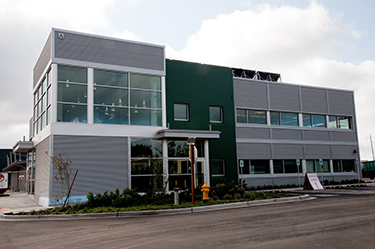|
Subscribe / Renew |
|
|
Contact Us |
|
| ► Subscribe to our Free Weekly Newsletter | |
| home | Welcome, sign in or click here to subscribe. | login |
Environment
| |
 |
February 26, 2015
How to convince a realist it makes sense to go green
KPG

Dean
|
How do design professionals and policymakers frame the issues surrounding sustainable design, construction and operation to more effectively inform business owners, developers and public agencies about the benefits of sustainable projects?
As architects and engineers, we work with clients every day on projects with and without sustainability goals.
A few public agencies in our region have mandatory sustainability requirements, such as LEED silver, gold or even platinum. At the other end of the spectrum we find clients that are positively averse to LEED because they believe attention to sustainability will increase their capital improvement costs. Finally, there are clients who are somewhere in between — they philosophically agree with the concept of sustainability but specific sustainability metrics are not part of their project requirements.
Unfortunately, the power of the sustainability message gets diluted when it becomes about making a statement, proving a point, challenging conventions or even checking a box for meeting an imposed project requirement. For the forward-thinking, idealistic client, sustainability is about making the world a better place for future generations. For the business-oriented, realistic client, sustainability must be about the bottom line.
This latter group of clients is the primary target for advancing sustainability in a profound and meaningful way.
A few strategies
Make no mistake — how architects and engineers design buildings and shape building sites directly affects operation and maintenance costs. It is critical for designers to embrace this and for building owners to be enlightened about how it affects their bottom line.
Our industry must openly address the pros and cons of sustainable strategies and what they mean to our clients’ capital improvement and operating budgets. This requires honest discussions and a clear understanding of what it means to own and operate a sustainable building and site.
In our experience, a few sustainability strategies to consider for every project regardless of sustainability goals include:
• “Right-sizing” the program and site to build only what is necessary.
• Considering low- or no-maintenance materials and systems.
• Giving preference to passive systems over active systems.
• Prioritizing ease and frequency of maintenance in the decision-making process.
These strategies may appear basic or simple on the surface, but they present opportunities for great debate, design iteration and coordination issues that may push the envelope for many designers. Often the most cost-effective construction solution is the most cost-effective operation and maintenance solution.
Long-term savings
Does sustainable design and construction make financial sense?
The short answer is yes. Many sustainable design strategies result in positive budgetary effects that can be compounded with operationally minded design (design that prioritizes operational and maintenance needs).
This topic has been debated exhaustively and tends to revolve around life-cycle cost analysis and environmental cost. Unfortunately, life-cycle cost analysis is not a universally understood tool or concept, and can focus on details that skew the overall message.
If conceived in a responsible manner, and designers and builders do their job in an integrated fashion, building owners should expect to realize cost savings over the life of their building. In most cases sustainability does in fact mean that more upfront capital improvement dollars are needed, although, when the budget is expanded to include ongoing ownership costs such as operation, maintenance and labor (staffing), our experience tells us that total cost of ownership can be significantly reduced.
Beyond ratings
It is important to note that sustainability goes well beyond the metrics of LEED and other sustainable rating systems.
Rating systems do not account for practices such as right-sizing facilities, which can be more effective at reducing the carbon footprint than other strategies tracked by sustainable rating systems. Critically analyzing the program and client needs in order to design and build only what is needed reduces material needs and site development costs.
The proper perspective is critically important. A building’s often thin capital improvement budget has a direct impact on the operation and maintenance budget. But the operation and maintenance budget will continue to be tapped into for the life of facility, while the capital improvement budget is typically closed when construction is complete.
Operation and maintenance costs, not capital improvement costs, easily represent the largest expenses over a building’s life. This makes them the biggest target for budget-reduction opportunities. If the appropriate strategies are prioritized and implemented, then sustainability can result in a facility that is closer to being self-sufficient.
The expected result of facility self-sufficiency is lower operation and maintenance costs, which can reduce the lifetime O&M budget exponentially.
We encourage designers, developers and owners to embrace undefined or vague sustainability goals. A sensible project approach, void of often improperly imposed sustainability requirements, is an opportunity to shape a building and site that an owner’s budget can benefit from and occupants will thrive in.
A positive sustainable design, construction and operation experience makes for happy owners, resulting in more sustainable project opportunities.
DJ Dean is the principal architect at KPG, an interdisciplinary design firm with offices in Seattle and Tacoma.
Other Stories:
- Energy tools that could change the game
- Why green building has hit the wall, and what to do about it
- How to make a better business case for going green
- Making the most of your energy model
- Seattle is clamping down on waste from construction and demolition
- How to treat stormwater in urban areas — like Totem Lake
- Goal of Capitol Hill EcoDistrict is to make neighborhood green
- How do you measure the value of a green building?
- Six reasons developers should build net-zero apartments
- Federal Center South team focused on results, not ratings



